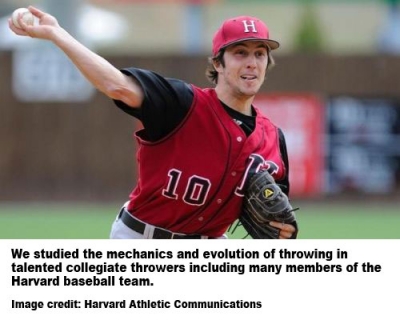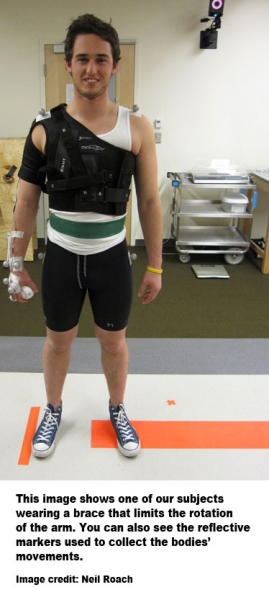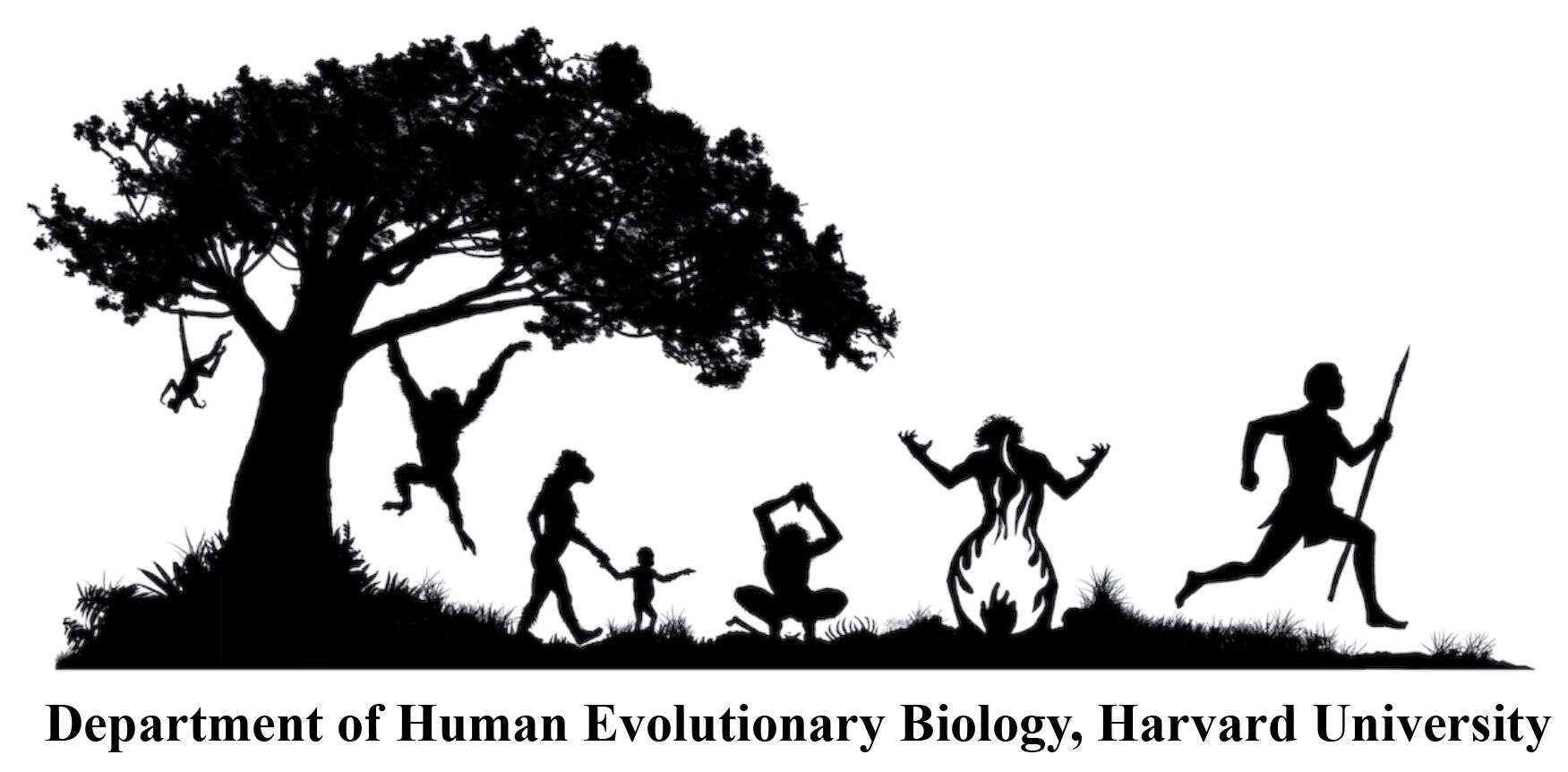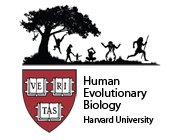Why throwing?
Humans are amazing throwers. We are unique among all animals in our ability to throw projectiles at high speeds and with incredible accuracy. Professional baseball pitchers and cricket bowlers are capable of throwing a ball more than 90 miles-per-hour, over and over again throughout the course of a game. Even 12-13 year old Little League pitchers routinely throw 60-70 mph!

Our ability to produce high-speed throws is even more impressive when compared to the throwing ability of our closest relatives, chimpanzees. Despite being incredibly strong and very athletic, an adult male chimp that has been trained to throw can only throw a ball approximately 20 mph.
Today, our unique throwing ability is used almost exclusively during sports. However, that was not always the case. Until only a few thousand years ago, most humans hunted and gathered their food from the natural environment around them. There are many accounts in historic times of human hunter-gatherers throwing projectiles to hunt and to defend themselves. We think that it is in these contexts that our remarkable throwing ability evolved.
Our Study

We started our study with two basic questions: How do humans throw so well? When and why did this throwing ability evolve? To answer these questions we conducted a series of experiments designed to uncover the mechanics of how humans produce powerful throws and how changes to our upper bodies that occurred during human evolution would affect those mechanics.
To study these questions, we brought collegiate baseball players into Dan Lieberman’s Skeletal Biology lab at Harvard and the Wyss Institute Motion Capture lab at Harvard Medical School. Here we collected body size measurements, attached reflective markers to each segment in their upper body, and recorded the movement of those markers in 3D using an infrared motion capture system as they threw baseballs. This camera system is similar to those used to make video games and animate movie characters (eg. Gollum in the Lord of the Rings).

Using those 3D movement data, we then constructed a computer model of the throwing motion and analyzed each throw using inverse dynamics analysis. This analysis uses simple physics to break down complex movements into the individual motions occurring at each joint and estimates the forces needed to create those motions.
In addition to recording and studying normal throwing, we also used therapeutic braces to limit our throwers’ movements. These braces allowed us to mimic our ancestral anatomy in modern throwers, giving us the opportunity to see how anatomical changes that occurred during our evolutionary past would have affected our ability to throw.
How do humans throw so well?
We found that humans are able to throw with such velocity by storing elastic energy in their shoulders. This is accomplished by positioning the arm in such a way that the arm’s mass resists motions generated at the torso and shoulder and rotates backwards away from the target. This “cocking” of the arm stretches the tendons, ligaments, and muscles crossing the shoulder and stores elastic energy (like a slingshot). When this energy is then released, it powers the very rapid rotation of the upper arm, which is the fastest motion the human body produces – up to 9,000 degrees-per-second in professional pitchers! This rapid rotation also causes the elbow to quickly straighten and the projectile to be released at very high speeds.
We further found that three key anatomical changes that occurred during human evolution made this novel energy storage mechanism possible: expansion of the waist, lowering of the shoulders, and low humeral torsion. The expansion of the waist allows the torso to rotate independently from the hips. This torso rotation generates large forces needed to stretch the elastic tendons and ligaments in the shoulder. The lowering of the shoulder changes the orientation of many shoulder muscles, including the pectoralis major (the large chest muscle), which is crucial to storing energy. Finally, we found that low humeral torsion (the twisting of the upper arm bone) allows us to store more energy and thus, throw faster.
What is elastic energy?
 Elastic energy is potential mechanical energy that animals store in tendons, ligaments, and muscles. When these structures are stretched they elongate like an elastic band. When the forces pulling on these elements are then reduced, they return to their original shape, releasing the energy that was used to stretch them. This elastic energy can be used to power forceful movements (such as a frog’s jump) or to make movement more energetically efficient (such as the human Achilles tendon during running). Our study is the first to demonstrate the use of elastic energy in the human arm.
Elastic energy is potential mechanical energy that animals store in tendons, ligaments, and muscles. When these structures are stretched they elongate like an elastic band. When the forces pulling on these elements are then reduced, they return to their original shape, releasing the energy that was used to stretch them. This elastic energy can be used to power forceful movements (such as a frog’s jump) or to make movement more energetically efficient (such as the human Achilles tendon during running). Our study is the first to demonstrate the use of elastic energy in the human arm.
When and why did this throwing ability evolve?
The three anatomical shifts in the upper body that we found affected throwing performance are first seen together nearly 2 million years ago in the species Homo erectus. At this same time, we see evidence of intensified hunting activity by our hominin ancestors (butchered fossil bones, simple stone tools).
We propose that the ability to throw with speed and accuracy evolved as an adaptation that helped our ancestors become more successful hunters. Without any advanced weapons or technology such as bows or snares (which were not invented for more than 1.5 million years), our ancestors were likely hunting with little more than rocks and sharpened wooden spears. The ability to throw such simple weapons fast and accurately would have been a huge advantage, allowing hominins to hunt dangerous prey from a safe distance.
 Hunting, and by extension throwing, had profound effects on our ancestors biology and way of life. The inclusion of high-protein meat and calorie-rich fat dramatically improved the quality of our ancestors’ diet. These additional calories allowed our hominin ancestors to grow large bodies, larger brains, and have more children. Each of these changes had very profound effects on our biology and are crucial to making humans who we are today. For example, a larger brain is thought to be critical to our cognitive abilities, including the development of language.
Hunting, and by extension throwing, had profound effects on our ancestors biology and way of life. The inclusion of high-protein meat and calorie-rich fat dramatically improved the quality of our ancestors’ diet. These additional calories allowed our hominin ancestors to grow large bodies, larger brains, and have more children. Each of these changes had very profound effects on our biology and are crucial to making humans who we are today. For example, a larger brain is thought to be critical to our cognitive abilities, including the development of language.
We think that hunting also probably changed the way our ancestors interacted with the world around them. For the first time, male and females likely divided their labor differently and shared food-getting tasks. Surpluses of meat from a large kill could be shared or eaten over a number of days, freeing time for other activities. As our ancestors became more reliant on hunting they would also have been free to move into new environments (such as deserts and mountainous areas) that previously would not have had enough fruits and vegetables to sustain them. This ability to move into new environments and thrive would have been crucial as our ancestors migrated out of Africa and spread throughout the world.
If we are evolved to throw, why do throwers get injured so frequently?
 While throwing may have been a crucial part of our hunting behavior until very recently, today most throwing is done in the context of sports. Modern athletes use the same energy storage mechanism to now throw balls instead of spears. Yet, modern throwing athletes often suffer from injuries to their shoulders and elbows caused by the high forces our unique throwing ability enables. This is likely caused by the increased frequency with which modern athletes throw.
While throwing may have been a crucial part of our hunting behavior until very recently, today most throwing is done in the context of sports. Modern athletes use the same energy storage mechanism to now throw balls instead of spears. Yet, modern throwing athletes often suffer from injuries to their shoulders and elbows caused by the high forces our unique throwing ability enables. This is likely caused by the increased frequency with which modern athletes throw.
For example, a professional baseball pitcher can easily throw more than 100 very fast pitches over a 2-3 hour period. This is considerably more than our hominin ancestors would have thrown when practicing and using this behavior to hunt. We think that despite being evolved to throw, the overuse of our ability to throw projectiles at high speeds is causing excessive wear and tear to our bodies and making injuries common.




 Elastic energy is potential mechanical energy that animals store in tendons, ligaments, and muscles. When these structures are stretched they elongate like an elastic band. When the forces pulling on these elements are then reduced, they return to their original shape, releasing the energy that was used to stretch them. This elastic energy can be used to power forceful movements (such as a frog’s jump) or to make movement more energetically efficient (such as the human Achilles tendon during running). Our study is the first to demonstrate the use of elastic energy in the human arm.
Elastic energy is potential mechanical energy that animals store in tendons, ligaments, and muscles. When these structures are stretched they elongate like an elastic band. When the forces pulling on these elements are then reduced, they return to their original shape, releasing the energy that was used to stretch them. This elastic energy can be used to power forceful movements (such as a frog’s jump) or to make movement more energetically efficient (such as the human Achilles tendon during running). Our study is the first to demonstrate the use of elastic energy in the human arm. Hunting, and by extension throwing, had profound effects on our ancestors biology and way of life. The inclusion of high-protein meat and calorie-rich fat dramatically improved the quality of our ancestors’ diet. These additional calories allowed our hominin ancestors to grow large bodies, larger brains, and have more children. Each of these changes had very profound effects on our biology and are crucial to making humans who we are today. For example, a larger brain is thought to be critical to our cognitive abilities, including the development of language.
Hunting, and by extension throwing, had profound effects on our ancestors biology and way of life. The inclusion of high-protein meat and calorie-rich fat dramatically improved the quality of our ancestors’ diet. These additional calories allowed our hominin ancestors to grow large bodies, larger brains, and have more children. Each of these changes had very profound effects on our biology and are crucial to making humans who we are today. For example, a larger brain is thought to be critical to our cognitive abilities, including the development of language. While throwing may have been a crucial part of our hunting behavior until very recently, today most throwing is done in the context of sports. Modern athletes use the same energy storage mechanism to now throw balls instead of spears. Yet, modern throwing athletes often suffer from injuries to their shoulders and elbows caused by the high forces our unique throwing ability enables. This is likely caused by the increased frequency with which modern athletes throw.
While throwing may have been a crucial part of our hunting behavior until very recently, today most throwing is done in the context of sports. Modern athletes use the same energy storage mechanism to now throw balls instead of spears. Yet, modern throwing athletes often suffer from injuries to their shoulders and elbows caused by the high forces our unique throwing ability enables. This is likely caused by the increased frequency with which modern athletes throw.


